#Aluminosilicate
Explore tagged Tumblr posts
Text
Did you know
South Africa is the world's biggest producer of gold, platinum, chromium, vanadium, manganese and aluminosilicates
#did you know#fact or fiction#south africa#gold#platinum#chromium#vanadium#manganese#aluminosilicate
15 notes
·
View notes
Text

#prehnite#rocks#rocks and minerals#rock#specimen#sample#green#morocco#Moroccan#crystal#crystals#minerals#translucent#aluminosilicate
2 notes
·
View notes
Text
Aluminosilicate Prices: Trend | Pricing | News | Price | Database
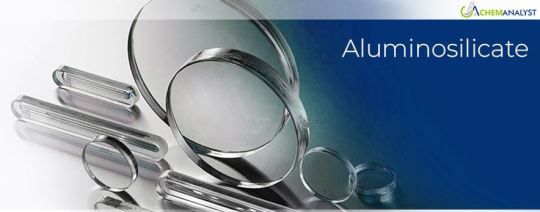
Aluminosilicates Prices a group of minerals widely used in various industries, are experiencing dynamic shifts in pricing trends driven by market demand, supply constraints, and technological advancements. These minerals, comprising aluminum, silicon, and oxygen, play a vital role in sectors such as construction, petrochemicals, ceramics, and environmental applications. The market for aluminosilicates is influenced by their diverse applications, particularly in producing zeolites, refractories, and catalysts. Zeolites, one of the most prominent products derived from aluminosilicates, are highly sought after in water treatment, detergents, and petrochemical refining, making their demand a significant driver of aluminosilicate prices globally.
The aluminosilicate market is shaped by several key factors, including raw material availability, production costs, and regulatory policies. Natural aluminosilicates, such as feldspar and kaolin, are mined in specific geographic regions, creating regional price disparities. Additionally, synthetic aluminosilicates, which are engineered for high purity and specific applications, often carry a premium price due to their complex manufacturing processes. Rising energy costs have also contributed to fluctuating prices, as aluminosilicate production is energy-intensive, particularly in synthesizing zeolites and manufacturing ceramics. These cost pressures are exacerbated by global inflationary trends, impacting the overall pricing landscape.
Get Real time Prices for Aluminosilicates: https://www.chemanalyst.com/Pricing-data/aluminosilicate-1518
The construction industry's growing demand for lightweight and durable materials has significantly contributed to the increased consumption of aluminosilicates. As a result, prices have risen steadily, especially in markets like Asia-Pacific, where rapid urbanization and infrastructure development are driving demand. Aluminosilicates are integral to manufacturing high-strength ceramics and refractories, crucial for construction projects requiring thermal and mechanical stability. With nations prioritizing sustainable and long-lasting construction practices, the demand for these minerals is expected to remain robust, further influencing their market valuation.
Environmental regulations and sustainability concerns have also played a pivotal role in shaping aluminosilicate prices. Industries are increasingly adopting zeolite-based solutions for applications such as air purification, water treatment, and carbon capture, owing to their eco-friendly properties. As governments and organizations push for stricter emission control measures, the demand for zeolites has surged, creating upward pressure on aluminosilicate prices. Furthermore, advancements in green chemistry and circular economy practices have encouraged the development of innovative aluminosilicate applications, such as in renewable energy technologies, thereby expanding their market scope and influencing pricing dynamics.
The aluminosilicate market is also impacted by global trade dynamics and geopolitical factors. Disruptions in supply chains, trade tariffs, and export restrictions in key aluminosilicate-producing countries can lead to price volatility. For example, the availability of raw materials like feldspar and kaolin, primarily sourced from regions such as China, India, and Brazil, is subject to mining regulations and environmental policies in these countries. Any changes in these policies can significantly alter the supply-demand equilibrium, affecting prices worldwide. Similarly, geopolitical tensions can disrupt trade flows, leading to temporary shortages and price spikes in import-dependent regions.
Technological advancements and innovations in manufacturing processes have provided some relief in controlling production costs and stabilizing prices. For instance, modern methods of synthesizing zeolites and other high-performance aluminosilicates have enabled producers to achieve better efficiency and consistency. However, these advancements require substantial capital investment, which is often reflected in the product's final price. The ongoing research into optimizing aluminosilicate applications across industries, such as improving their catalytic efficiency in petrochemical processes or enhancing their durability in ceramics, also adds to the pricing considerations as manufacturers seek to recover R&D expenses.
Regional markets exhibit varying trends in aluminosilicate prices, influenced by local demand patterns, industrial growth, and resource availability. In North America and Europe, where environmental regulations are stringent, the demand for high-purity aluminosilicates, particularly zeolites, is high. This demand has supported steady price growth, especially in applications related to emission control and water purification. Conversely, in developing regions like Asia-Pacific, the market is driven more by the construction and ceramics industries, with prices reflecting the growing consumption of raw aluminosilicates. The Middle East and Africa, though smaller in market share, are witnessing increased demand for aluminosilicates in petrochemical refining, supported by regional oil and gas activities.
The future of aluminosilicate prices is expected to be influenced by global megatrends such as sustainability, digitalization, and urbanization. The transition towards renewable energy and green technologies is likely to amplify the demand for zeolites, especially in hydrogen production and carbon capture systems. Similarly, the growing emphasis on sustainable urban development will continue to drive demand for durable and eco-friendly construction materials, ensuring a steady market for aluminosilicates. However, challenges such as resource depletion, rising energy costs, and geopolitical uncertainties could pose risks to price stability in the coming years.
In conclusion, the aluminosilicate market is characterized by its complexity and responsiveness to diverse factors, ranging from industrial demand and environmental regulations to technological advancements and geopolitical dynamics. Prices are likely to remain dynamic, reflecting the interplay of these forces in a rapidly evolving global landscape. Businesses and stakeholders in the aluminosilicate industry must stay attuned to these trends, adapting their strategies to navigate challenges and capitalize on emerging opportunities in this critical market segment.
Get Real time Prices for Aluminosilicates: https://www.chemanalyst.com/Pricing-data/aluminosilicate-1518
Contact Us:
ChemAnalyst
GmbH - S-01, 2.floor, Subbelrather Straße,
15a Cologne, 50823, Germany
Call: +49-221-6505-8833
Email: [email protected]
Website: https://www.chemanalyst.com
#Aluminosilicate#Aluminosilicate Price#Aluminosilicate Prices#Aluminosilicate Pricing#Aluminosilicate News#Aluminosilicate Price Monitor#Aluminosilicate Database
0 notes
Text
More on Roman Concrete
I started this year off with a post on Roman concrete, and since this will be my last post for 2023, why not end with the same subject? You might think there cannot be much more to say about that, but that would be wrong. You may think that once you have concrete, it will be there forever; it is effectively a rock, but that is not true. First, there are a range of cements. The very first one was…
View On WordPress
#aluminosilicate#calcium silicate#cement range#construction maintenance#Portland cement#pozzolan#self-healing concrete#slaked lime
0 notes
Text
Why This Ingredient 3: Minerals
Part three of the ingredients and their uses series, minerals! Take care of your body: lick a rock today!
Very few of these are the minerals described in the article, but they look cool so here we are.Photo by Edz Norton on Unsplash Minerals are underrated. For a lot of minerals, only a tiny amount is needed for them to take an immense part in the body’s ability to stay alive and well. Many come from rocks, but often those rocky mineral sources are broken up and modified by plants, or simply mixed…

View On WordPress
#aluminosilicate#animal nutition#baking soda#bentonite#bicarbonate#calcium#carbonate#chloride#chlorine#cobalt#copper#diatom#diatomaceous#diatomaceous earth#dicalcium#dioxide#dolomite#dolomitic#educational#edutainment#ferrous#glucoheptonate#homestead#homesteading#iodate#iodine#iron#lime#limestone#lysine
2 notes
·
View notes
Text
Word List: Land

beautiful words with "land" to try to include in your poem/story
Bottomlands - low-lying land along a watercourse
Cloudland - the region of the clouds; the realm of visionary speculation or poetic imagination
Fairyland - the land of fairies; a place of delicate beauty or magical charm
Fantasyland - an imaginary or ideal place or situation
Fatherland - the native land or country of one's father or ancestors; one's native land or country
Garland - a circular or spiral arrangement of intertwined material (such as flowers or leaves); anthology, collection
Grassland - farmland occupied chiefly by forage plants and especially grasses; land on which the natural dominant plant forms are grasses and forbs
Heartland - a central area
Heulandite - a zeolite consisting of a hydrous aluminosilicate of sodium and calcium
Hinterland - a region lying inland from a coast; a region remote from urban areas
Interisland - existing, occurring, or operating between islands
Landaulet - a small landau (i.e., a four-wheel carriage with a top divided into two sections that can be folded away or removed and with a raised seat outside for the driver)
Landblink - a glow that is yellower than iceblink and that is seen in arctic regions over snow-covered land
Landlocked - enclosed or nearly enclosed by land
Landlubber - landsman (i.e., a fellow countryman; a person who lives on the land, especially: one who knows little or nothing of the sea or seamanship)
Landolphia - a genus of Old World tropical woody vines (family Apocynaceae) having large yellow or white cymose flowers with narrow lobes succeeded by large berrylike fruits
Landspout - a phenomenon like a waterspout but occurring over land
Landwrack - (or landwreck) obsolete: destruction of something on land; ruin, devastation
Lotusland - a place inducing contentment especially through offering an idyllic living situation
Marchland - land in or along border regions; borderland
Motherland - mother country; a country regarded as a place of origin (as of an idea or a movement)
Outlandish - strikingly out of the ordinary; bizarre
Pentlandite - a bronzy yellow mineral that is an isometric nickel iron sulfide and the principal ore of nickel
Vacationland - an area with recreational attractions and facilities for vacationers
Woodland - land covered with woody vegetation; timberland, forest; growing, living, or existing in woodland
If any of these words inspire your writing, do tag me or send me a link. I'd love to read your work!
More: Word Lists ⚜ Writing Resources PDFs
#word list#land#writing reference#spilled ink#dark academia#writeblr#literature#writers on tumblr#writing prompt#poetry#poets on tumblr#words#langblr#linguistics#writing inspiration#writing inspo#writing ideas#creative writing#fiction#light academia#martin johnson heade#art#nature#writing resources
259 notes
·
View notes
Text

Today's Specimen: Kyanite
Kyanite is a usually blue aluminosilicate. It can be found in high pressure environments rich with aluminum. Kyanite was first discovered in 1789, in Mt Greiner, Austria, but have since been found worldwide. These specimens have a 4.5-7.0 on the Mohs hardness scale, with hardness varying on each axis. This mineral contains toxic amounts of aluminum, and should not be wet. Alternate names for Kyanite include: Cyanite, Disthen, Sapparite.
Stay tuned for another rock talk!
85 notes
·
View notes
Text
The MePhone4 is a smartphone that was designed, developed, and marketed by Meeple Inc. It is the fourth generation of the MePhone lineup, succeeding the MePhone3GS and preceding the MePhone4s. Following a number of notable leaks, the MePhone4 was first unveiled on June 7, 2010, at Meeple's Worldwide Developers Conference in San Francisco, and was released on June 24, 2010, in the United States, United Kingdom, France, Germany, and Japan. The MePhone4 introduced a new hardware design to the MePhone family, which Meeple's CEO Steve Cobs touted as the thinnest smartphone in the world at the time; it consisted of a stainless steel frame which doubled as an antenna, with internal components situated between two panels of aluminosilicate glass. The MePhone4 introduced Meeple's new high-resolution "Retina Display" (with a pixel density of 326 pixels per inch), while maintaining the same physical size and aspect ratio as its precursors, Meeple's M4 system-on-chip, along with MeOS 4—which notably introduced multitasking functionality and app folders. It was the first MePhone at the time to include a front-facing camera, which made possible Meeple's new FaceTime video chat service, and the first to be released in a version for CDMA networks, ending AT&T's period as the exclusive carrier of MePhone products in the United States.
#inanimate insanity#inanimate insanity ii#inanimate insanity 2#inanimate insanity invitational#ii 2#ii3#mephone4 ii#ii mephone4#inanimate insanity mephone4#mephone4#this was made and sent from a discord server and guess what? it got pinned lol
27 notes
·
View notes
Text

Novel zeolite structure demonstrates superior heavy oil cracking efficiency
Researchers have developed a new aluminosilicate zeolite, ZMQ-1, which features a unique intersecting meso-microporous channel system that is expected to enhance catalytic processes in the petrochemical industry. The study, published in Nature, highlights ZMQ-1 as the first aluminosilicate zeolite with interconnected intrinsic 28-ring mesopores. This breakthrough overcomes long-standing challenges related to zeolite pore size limitation, stability, and catalytic efficiency. Zeolites are crystalline materials renowned for their applications in ion exchange, adsorption, and catalysis. However, their microporous structure limits their use in processing larger molecules. Researchers have addressed this limitation by developing a zeolite with intrinsic mesopores—pores larger than 20 Å—while maintaining stability and acidity.
Read more.
9 notes
·
View notes
Text
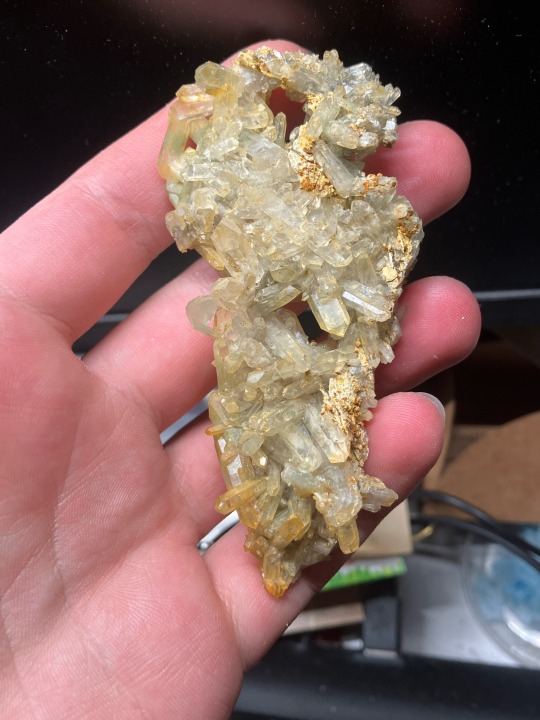
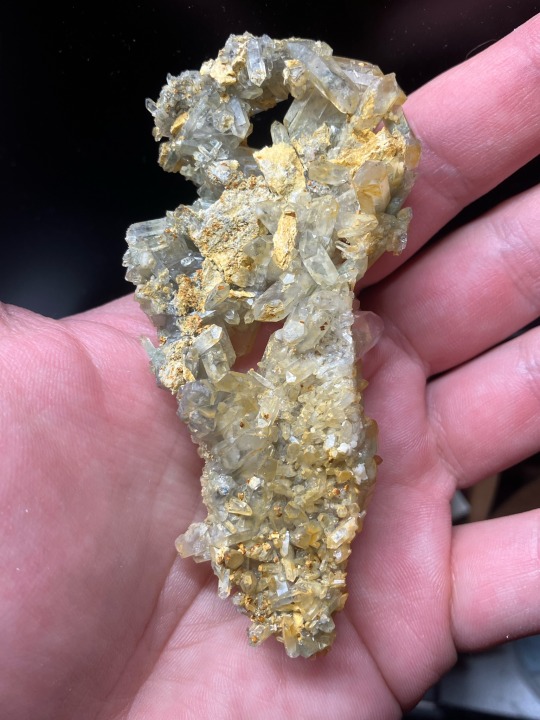
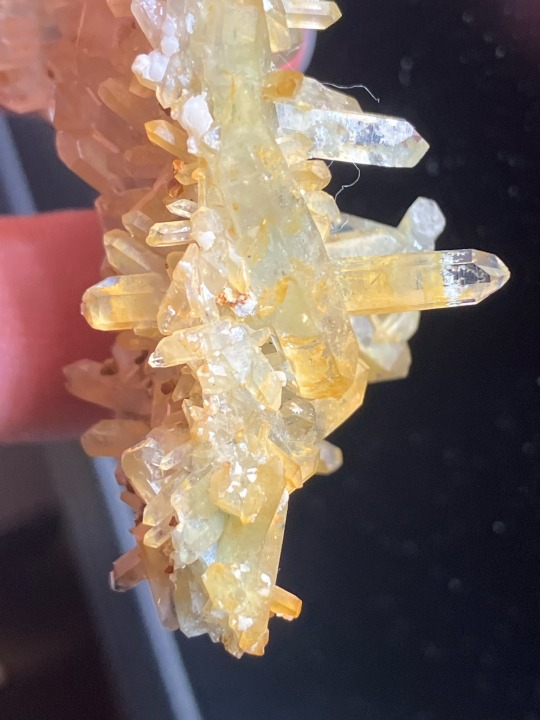
Mango Quartz (low grade)
Mango Quartz is as the name suggests another variety of Quartz.
This variety is characterised by yellow-orange coloration to the crystals, often their tips.
Like some other quartz varieties such as Ajoite Quartz, Dumortierite Quartz and Hematoid/Ferruginous Quartz, Mango Quartz gets this yellow-orange coloration from inclusions of another mineral called Halloysite.
Halloysite is an aluminosilicate clay mineral and a variety of Kaolinite Clay.
The mango quartz in these photos is a lower grade piece where the yellow-orange coloration isn’t immediately apparent.
I do have a higher grade piece I’ve yet to photograph but I’ll add the pics of that piece later.
2 notes
·
View notes
Text

Found a publically released photo of the lower(?) half of the Crater.
This is definitely a hexagonal crystal system. It looks a lot like beryl, actually, since it doesn't terminate at a point. Beryl with some kind of uniformly distributed inclusions. So I suppose I'll check for aluminosilicate minerals and beryllium first in the sample, and if I'm right, we can eliminate those from the spectrograph to see what the inclusion is, because normal beryl isn't iridescent, doesn't glow, and doesn't usually get as big as a building.
I could also be completely wrong, but we'll see. I should ask Steven what he thinks but I'm not sure he's even in Hoenn right now and the Devon stuff he gave me never seems to work when I use it.
#pkmn irl#area zero#most computers and phones in general never seem to work for me#dad's computer works fine though#he said he's happy that I started a blog to share this kind of stuff#and that he hopes it helps generate an interest in science from the public
12 notes
·
View notes
Text

0 notes
Text
Aluminosilicate Price | Prices | Pricing | News | Database | Chart
Aluminosilicate prices are a crucial aspect of the materials market, influenced by various factors including demand, production costs, and global economic conditions. Aluminosilicates are naturally occurring minerals that are primarily composed of aluminum, silicon, and oxygen. They are widely used in numerous industries, including ceramics, glass manufacturing, and construction, due to their unique properties such as thermal stability, mechanical strength, and chemical resistance. Understanding the trends and fluctuations in aluminosilicate prices can provide valuable insights for businesses and investors looking to navigate this dynamic market.
One of the primary drivers of aluminosilicate prices is the demand from the construction and ceramics industries. As global infrastructure projects continue to expand, the demand for aluminosilicate materials in the production of bricks, tiles, and ceramics has surged. This trend is particularly evident in emerging economies, where urbanization and industrialization are at their peak. Additionally, the rise of eco-friendly construction materials has further fueled the demand for aluminosilicates, which are often considered more sustainable compared to synthetic alternatives. Consequently, increased demand leads to upward pressure on prices, creating a significant impact on the overall market.
Get Real Time Prices for Aluminosilicate : https://www.chemanalyst.com/Pricing-data/aluminosilicate-1518
On the supply side, aluminosilicate prices are also affected by production costs, which can fluctuate based on the availability of raw materials and energy costs. Mining and processing aluminosilicate materials require significant energy inputs, and any increases in energy prices can lead to higher production costs. Additionally, changes in regulations regarding mining operations can impact the supply chain, further influencing prices. For instance, stricter environmental regulations may lead to increased operational costs for mining companies, which could be passed on to consumers in the form of higher prices.
Another important factor to consider is the global economic environment, which plays a pivotal role in shaping aluminosilicate prices. Economic downturns or slowdowns can lead to decreased demand for construction and manufacturing, resulting in lower prices. Conversely, during periods of economic growth, demand typically increases, leading to higher prices. Additionally, fluctuations in currency exchange rates can also impact pricing, particularly for companies that operate internationally or rely on imported raw materials. This interconnectedness of the global economy means that businesses must remain vigilant to shifts in market conditions that could affect aluminosilicate prices.
Seasonality can also influence the pricing of aluminosilicates. For example, certain times of the year, such as during construction season in many regions, may see increased demand for these materials, leading to price spikes. Similarly, during periods of extreme weather or natural disasters, demand may surge as reconstruction efforts begin, further impacting prices. Companies involved in the aluminosilicate supply chain must be aware of these seasonal trends to effectively manage their inventory and pricing strategies.
Technological advancements in the extraction and processing of aluminosilicates can also affect pricing. Innovations that enhance the efficiency of production processes or reduce waste can lead to lower costs and, consequently, lower prices for end consumers. As industries continue to prioritize sustainability and efficiency, companies that invest in such technologies may gain a competitive edge in the market, influencing overall pricing trends.
The competitive landscape of the aluminosilicate market is another critical factor that shapes pricing dynamics. A limited number of suppliers in certain regions can lead to monopolistic pricing behaviors, where a few dominant players set prices that may not reflect the true market value. Conversely, an oversupply of aluminosilicate materials in a particular area can drive prices down, benefiting consumers but potentially hurting producers. Companies must navigate this complex landscape, balancing their pricing strategies with competitive pressures and market conditions.
Additionally, geopolitical factors can significantly influence aluminosilicate prices. Trade policies, tariffs, and political stability in producing countries can all impact the availability and cost of these materials. For instance, trade disputes between major economies can lead to tariffs on imported aluminosilicates, resulting in increased prices for domestic consumers. Moreover, political instability in key producing regions can disrupt supply chains, further complicating pricing dynamics.
The ongoing global push towards sustainability and eco-friendliness is also shaping the aluminosilicate market. As industries strive to reduce their carbon footprint, there is an increasing demand for sustainable materials, including aluminosilicates. This shift can lead to higher prices as companies invest in eco-friendly production methods and materials. Additionally, the growing popularity of green building certifications may drive demand for specific types of aluminosilicates that meet stringent environmental standards, further influencing pricing trends.
In summary, aluminosilicate prices are influenced by a myriad of factors, including demand from key industries, production costs, global economic conditions, seasonality, technological advancements, market competition, geopolitical influences, and sustainability trends. As the market continues to evolve, businesses and investors must remain informed about these factors to effectively navigate the complexities of aluminosilicate pricing. By understanding the underlying drivers of price fluctuations, stakeholders can make more informed decisions, whether they are sourcing materials, planning investments, or developing strategies to compete in this dynamic market. Keeping a close eye on market trends and developments will be essential for those looking to leverage opportunities in the aluminosilicate sector, ensuring they are well-positioned to respond to changes and capitalize on growth potential in the coming years.
Get Real Time Prices for Aluminosilicate : https://www.chemanalyst.com/Pricing-data/aluminosilicate-1518
Contact Us:
ChemAnalyst
GmbH - S-01, 2.floor, Subbelrather Straße,
15a Cologne, 50823, Germany
Call: +49-221-6505-8833
Email: [email protected]
Website: https://www.chemanalyst.com
#Aluminosilicate#Aluminosilicate Price#Aluminosilicate Prices#Aluminosilicate Pricing#Aluminosilicate News#Aluminosilicate Price Monitor#Aluminosilicate Database
0 notes
Text
Where Are The Aliens?
It would seem most likely that our fascination with exoplanets includes our desire to see if we are alone in the Universe. Aliens will live on planets, at least when not travelling or occupying space stations, and space ships and space stations will be impossible to locate unless they broadcast signals that happen to come to us. Such signals will be highly directional to prevent attenuation over…
#aluminosilicates#LHS 1140b#origin of granite#planetary disk#planetary disk temperatures#rocky planets#water worlds
0 notes
Text
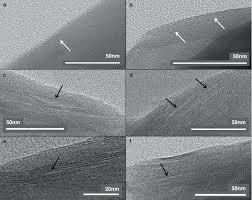
Meteorite-common amino acid induces formation of nanocavities in clay mineral
Researchers at the universities of Amsterdam and Utrecht have observed the formation of nanocavities in montmorillonite clay under exposure to gamma-aminobutyric acid, a molecule commonly found on meteorites. This hitherto unrecognised phenomenon could be relevant to the origin of life on Earth, by introducing 3D confined nano-environments in clay that might have facilitated life’s first chemistry. The findings have been reported in a paper in Communications Earth & Environment, a journal from the Nature family.
The research, carried out as a part of the Planetary and ExoPlanetary Science Programme (PEPSci) of the Dutch Research Council NWO, adds a novel dimension to the concept of the ‘warm little pond’. This primordial pond would have enabled the interaction of organics and minerals in a shallow water environment. The catalytic action of the minerals could thereby have led to the creation of the first molecules of life from simpler organic building blocks. Much research has been carried out into the interaction of clay minerals with organic molecules, especially those that could lead to the formation of Earth-like bio-polymers such as proteins and RNA.
The prebiotic molecular inventory, however, is expected to be diverse, also including molecules that were introduced to the Earth’s atmosphere through meteorites. In a novel approach, PhD candidate Orr Rose Bezaly and her supervisors Helen King (Utrecht University) and Annemieke Petrignani (University of Amsterdam) have now focused on the role of gamma-aminobutyric acid (GABA), a small molecule commonly found on meteorites. It has no known role in protein synthesis and has only a weak interaction with clays.
According to Petrignani it thus is a rather ‘unusual suspect’ regarding the origin of life. “However, because of its widespread occurrence on meteorites, we thought it would be interesting to investigate its potential role. The results really surprised us!”
Partial exfoliation leading to nanocavities
In laboratory experiments, the researchers exposed the common clay montmorillonite (a layered aluminosilicate mineral) to a range of GABA concentrations. Using infrared spectroscopy, X-ray crystallography and transmission electron microscopy, they were able to reveal that the weak interaction of GABA with the clay induce a process of partial exfoliation, where clay layers are ‘peeled away’. The process, that initiates in the mid-layers of the clay, is also correlated with the formation of nanoscale cavities in between clay layers.
According to Petrignani, exfoliation is widely investigated, especially in material sciences, but this atypical partial exfoliation has not been addressed and is also new in the field of origin of life. “We are the first to report on this, and we think it can be quite relevant. The nanoscale cavities we observe could facilitate the compartmentalisation that is a fundamental requirement of a prebiotic system.”
Orr Rose Bezaly explains that such nanocompartments can foster a local disequilibrium within the larger scale prebiotic chemical environment, driving the synthesis of crucial molecules. “In the prebiotic context this is most relevant to chemistry that requires low water activity, such as polymerisation. This should somehow be coupled with compartmentalisation - another critical function of life. Our discovery thus points us towards a feasible research route aimed at understanding nanoscale processes leading to the emergence of life. Beyond this field, the exfoliation method described in our work may be used as a sustainable technique for clay treatment for manipulation and synthesis of new materials”.
An exciting lead for new research
Petrignani is excited but emphasizes that it is too early to make any claims. “We need more research to obtain deeper insights, for instance into the chemical dynamics in the nanocavities, what formation pathway could be induced, and also if novel, larger molecules are formed, how these could then leave the cavities. So we do see compartments emerging and we think these could play a role in the emergence of life. But we are far from being able to say that with certainty.”
0 notes
Text
0 notes